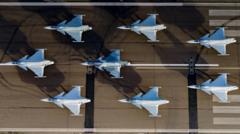As the global geopolitical landscape shifts, Sweden and Finland are emerging as dynamic players in the NATO defence framework, showcasing enhanced trust and opportunities in their defence industries.
Sweden and Finland's NATO Membership Sparks Defence Industry Growth

Sweden and Finland's NATO Membership Sparks Defence Industry Growth
The recent admission of Sweden and Finland into NATO has unlocked doors for the defence sectors of both nations, propelling economic benefits and reshaping their security landscape.
Sweden's defence giant Saab is capitalizing on its recent NATO membership, which was finalized in March 2024, as the company shifts its perspective from a historically neutral stance to becoming a valued ally in international defence. Micael Johansson, CEO of Saab, noted that the company has secured pivotal framework agreements with the NATO Support and Procurement Agency (NSPA), marking a significant change in access to NATO's inner workings that previously eluded them. This newfound alignment elevates both Sweden and Finland's roles amid Europe’s challenges following Russia's invasion of Ukraine in 2022, prompting both Nordic countries to seek NATO membership shortly after.
With full NATO membership acquired, both Sweden and Finland report increased defence spending, surpassing that of many older members within the alliance. Sweden’s military expenditure is projected to reach between 2.6% and 3% of GDP over the next three years, reflecting a robust commitment to national security. Finnish Ambassador to the UK, Jukka Siukosaari, highlighted the advantages of equal footing within NATO, paving the way for collaborations that benefit both nations' defence sectors.
These developments have resulted in many contracts, revitalizing the private defence industries in both countries. Increased spending by NATO members on defence initiatives will necessitate cooperation among various suppliers, potentially bolstering business for smaller defence firms and startups that can innovate with advanced technologies.
The transformation of Northern Europe’s defence landscape encompasses a spectrum of collaborative military efforts, from creating new NATO bases to the establishment of a Joint Nordic Air Command that melds resources between Finland, Sweden, Norway, and Denmark. Additionally, the emphasis on replenishing stockpiles of high-tech weaponry and investing in new aerial and underwater surveillance systems reflects attendees' priority to counter rising tensions with Russia.
While the recent geopolitical climate stimulates opportunities, it also prompts the need for a nuanced approach to trans-Atlantic defence collaborations. European nations must navigate the complexities of interdependence on existing systems while factoring in their drive for autonomy and increased competitiveness within the defence sector. As the need for a "Total Defence" framework emerges, nations are realizing that a comprehensive strategy encompassing both defence and civilian infrastructure is crucial for lasting security.
Amid these changes, the shift in the perception of Sweden and Finland within NATO creates a fertile ground for new technological advancements and collaborative initiatives that promise to redefine the parameters of defence cooperation in Europe. Both nations are now poised to share invaluable insights and strategies from their experiences, potentially reshaping the future landscape of collective security within the alliance.























